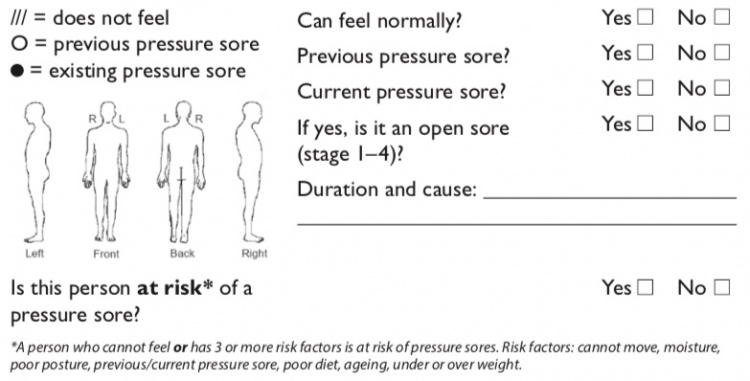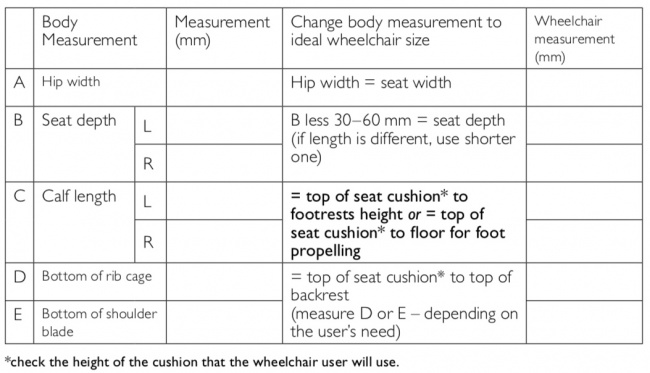Wheelchair Assessment - Physical Assessment
Original Editor - Your name will be added here if you created the original content for this page.
Top Contributors - Naomi O'Reilly, Rucha Gadgil, Tarina van der Stockt, Kim Jackson, Amrita Patro and Olajumoke Ogunleye
Introduction[edit | edit source]
Physical assessment is the second part of the assessment process and includes:
- Identifying the Presence, Risk of or History of Pressure Areas;
- Identifying the Method of Propulsion;
- Finding out how the wheelchair user sits and what additional postural support they may need through:
- observation sitting posture without support;
- carrying out a pelvis and hip posture screen, which identifies how any problems around the pelvis or hips may affect the wheelchair user’s sitting posture;
- carrying out hand simulation to ‘simulate’ the support that a wheelchair and additional postural supports may provide;
- taking measurements.
Information from each of these sections will help wheelchair service personnel to decide how much support the wheelchair user needs.
Identifying the Presence, Risk of or History of Pressure Areas[edit | edit source]

Mark on the body diagram:
- areas where the wheelchair user cannot feel; like this: ////
- areas where the wheelchair user has had a pressure sore in the past; like this: O
- areas where the wheelchair user has a current pressure sore; like this:
If a wheelchair user highlights that they have a pressure area, always ask to see it. Ensure this is done in a private area. Remember any wheelchair user at risk of developing a pressure sore needs a pressure relief cushion and education on preventing pressure sores. A wheelchair user is at risk of developing a pressure area if they cannot feel or have other risk factors including:
- decreased sensation;
- decreased mobility and/or paralysis;
- moisture from sweat, water or incontinence;
- poor posture;
- previous or current pressure sore;
- poor diet and not drinking enough water;
- ageing;
- weight (underweight or overweight).
Identifying the Method of Propulsion[edit | edit source]
It is important to find out what method of propulsion the wheelchair user will use to push, as this can affect the choice of wheelchair and the way it is set up.
Taking Measurements[edit | edit source]
Four measurements from the wheelchair user are needed to choose the best available size of wheelchair for that person. each measurement relates to the wheelchair.
Measuring Tools[edit | edit source]
- Use a retractable metal tape measure
- clipboards/books can be used to help measure accurately (see How to take body measurements).
- Large callipers are an additional tool that can be very useful. These can be made locally from wood.
- Foot-blocks can be used to support the wheelchair user’s feet at the correct height.
How To Take Body Measurements[edit | edit source]
- Ask the wheelchair user to sit as upright as possible.
- The wheelchair user’s feet should be supported on the floor or on foot-blocks if they cannot reach the floor comfortably.
- For all measurements, make sure the tape measure is held straight and the wheelchair user is sitting upright. Holding a clipboard/book on either side of the wheelchair user can help in obtaining an accurate measurement.
- Bend down to ensure you are viewing the tape measure at the correct angle.
Assessing Wheelchair Skills[edit | edit source]
- Finding out how the wheelchair user sits and what additional postural support they may need through:
- Observing sitting posture without support;
- Carrying out a pelvis and hip posture screen. Pelvis and hip posture screening helps to understand how any problems around the pelvis or hips may be affecting the wheelchair user’s sitting posture;
- Carrying out hand simulation. The wheelchair service personnel uses their hands to ‘simulate’ the support that a wheelchair and additional postural supports may provide;
- Taking Measurements.








